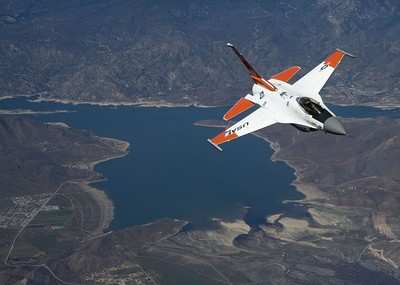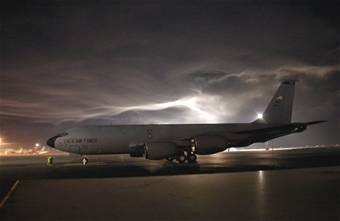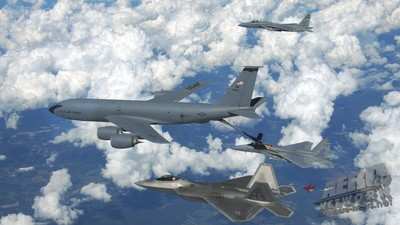Engineers Test ARAI: Automatic Receiver Aircraft
Identification
Engineers at the Air Force Flight Test Center at Edwards Air
Force Base are testing a system known as the Automatic Receiver
Aircraft Identification, or ARAI. Currently installed on a test
aerial refueler, if the tests are successful, Air Force officials
say the system will significantly improve air-to-air refueling.

RFID Equipped F-16
The ARAI is designed to be installed on a KC-135 Stratotanker to
make the air-to-air refueling to a receiver aircraft more efficient
and economical. Phase 2 testing for the ARAI has begun here, which
included a flight test April 7 using an NKC-135 test tanker
equipped with ARAI and an F-16 Fighting Falcon equipped with radio
frequency identification, or RFID, tags. The NKC-135 will use its
ARAI antennas to scan the F-16 for recognition and to accurately
gauge the amount of fuel transferred.
"It's an inventory control measure similar to what the large
department stores have," said Steve Walden, AFFTC test operations
project manager. "It's a similar process to when you walk through
the passive system at the door, the tags on the backs of CDs and
DVDs are automatically inventoried. That is ARAI in the tanker,
fly-up inventory control."

File Photo
Currently, when an airplane approaches a KC-135 for fuel, the
receiver aircraft's information is manually tracked by the boom
operator. Information for the receiver plane, such as tail number
and squadron, must either be visually identified or communicated by
radio. During night operations and radio silence situations, doing
this can be complicated.
"(ARAI) helps clean up the process so the boomer can focus on
what's really important, refueling the aircraft and completing the
mission, rather than administrative tasks," said Karen Etzkorn, a
Boeing systems engineer and principal investigator. Ms. Etzkorn
added that when visual identification and communications are
hindered for some reason, it takes longer for the KC-135 crew to
accurately log the aircraft and fuel information after the
refueling process is finished, or sometimes after they land.
Manually entered information can be inaccurate and thus costly.
With the ARAI/RFID system, a receiver aircraft with the RFID tags
can be scanned by the ARAI and all data retrieved is logged into a
computer aboard the tanker. Accurate information is important
because when an aircraft is refueled by a KC-135, the receiver's
squadron is responsible for the fuel cost. "There's millions of
dollars lost every year because of tracking for fuels that are
unaccounted for or allocated incorrectly," Mr. Walden said. "When
you go into a certain situation when there's no communication
(between the two aircraft), you have to estimate and that's when
you could lose money."

File Photo
Mr. Walden said the ARAI system could potentially save the Air
Force money by accurately tracking the amount of fuel downloaded
and charging squadrons the proper dollar amount. Air Force
officials would be able to budget their fuel needs and costs more
efficiently.
The Phase 2 KC-135 ARAI testing is part of the 'proof of
concept' portion of the testing process, which includes aerial
testing. Once Phase 2 is complete, the testing results and data
will be forwarded to Air Force Materiel Command officials for
review.
 NTSB Prelim: Piper PA-23
NTSB Prelim: Piper PA-23 Classic Aero-TV: One Mans Vietnam
Classic Aero-TV: One Mans Vietnam NTSB Final Report: Capella Aircraft Corp FW1C50
NTSB Final Report: Capella Aircraft Corp FW1C50 Classic Aero-TV: Timber Tiger Touts Curtiss Jenny Replicas
Classic Aero-TV: Timber Tiger Touts Curtiss Jenny Replicas ANN's Daily Aero-Term (07.04.25): Performance-Based Navigation (PBN) [ICAO]
ANN's Daily Aero-Term (07.04.25): Performance-Based Navigation (PBN) [ICAO]





